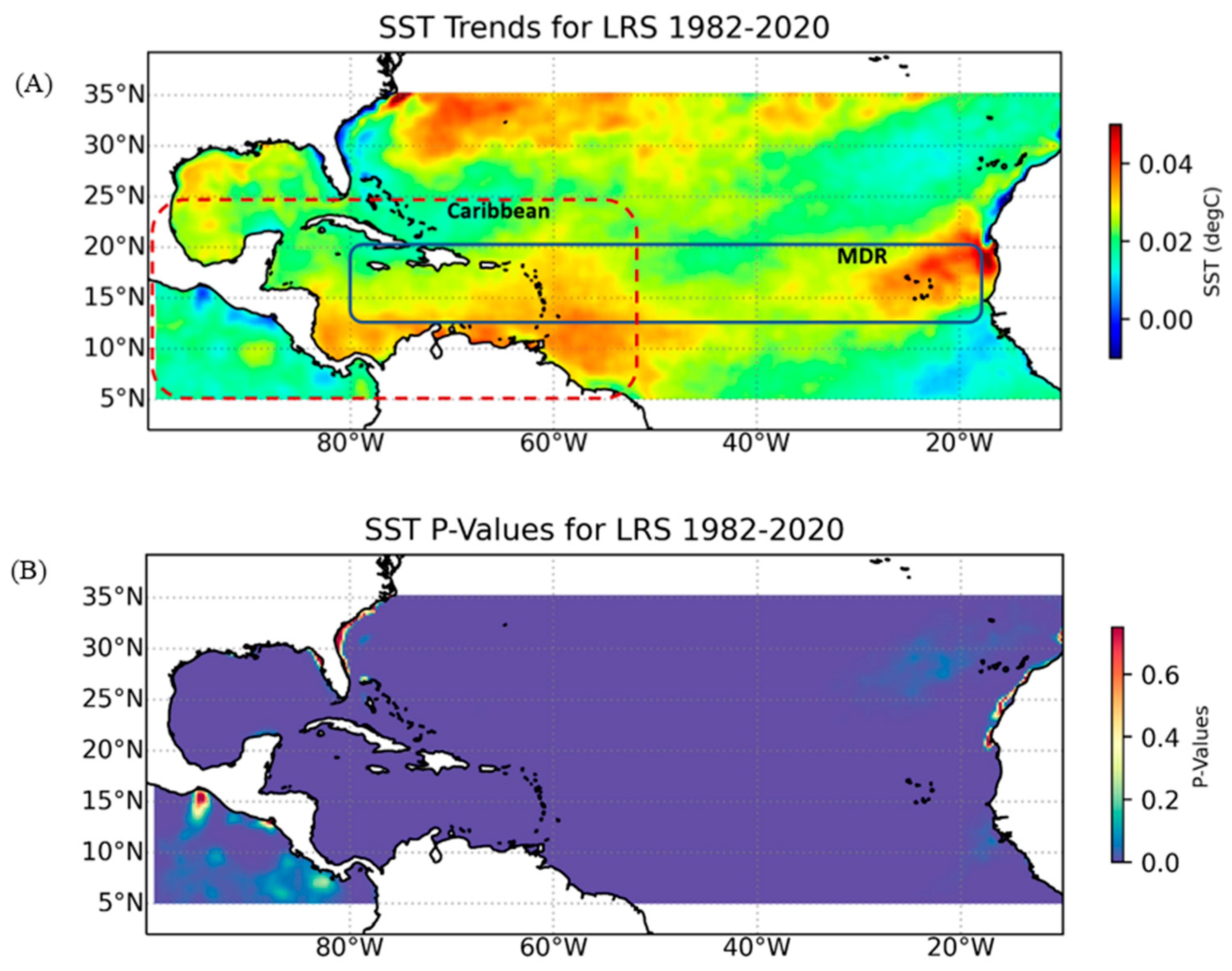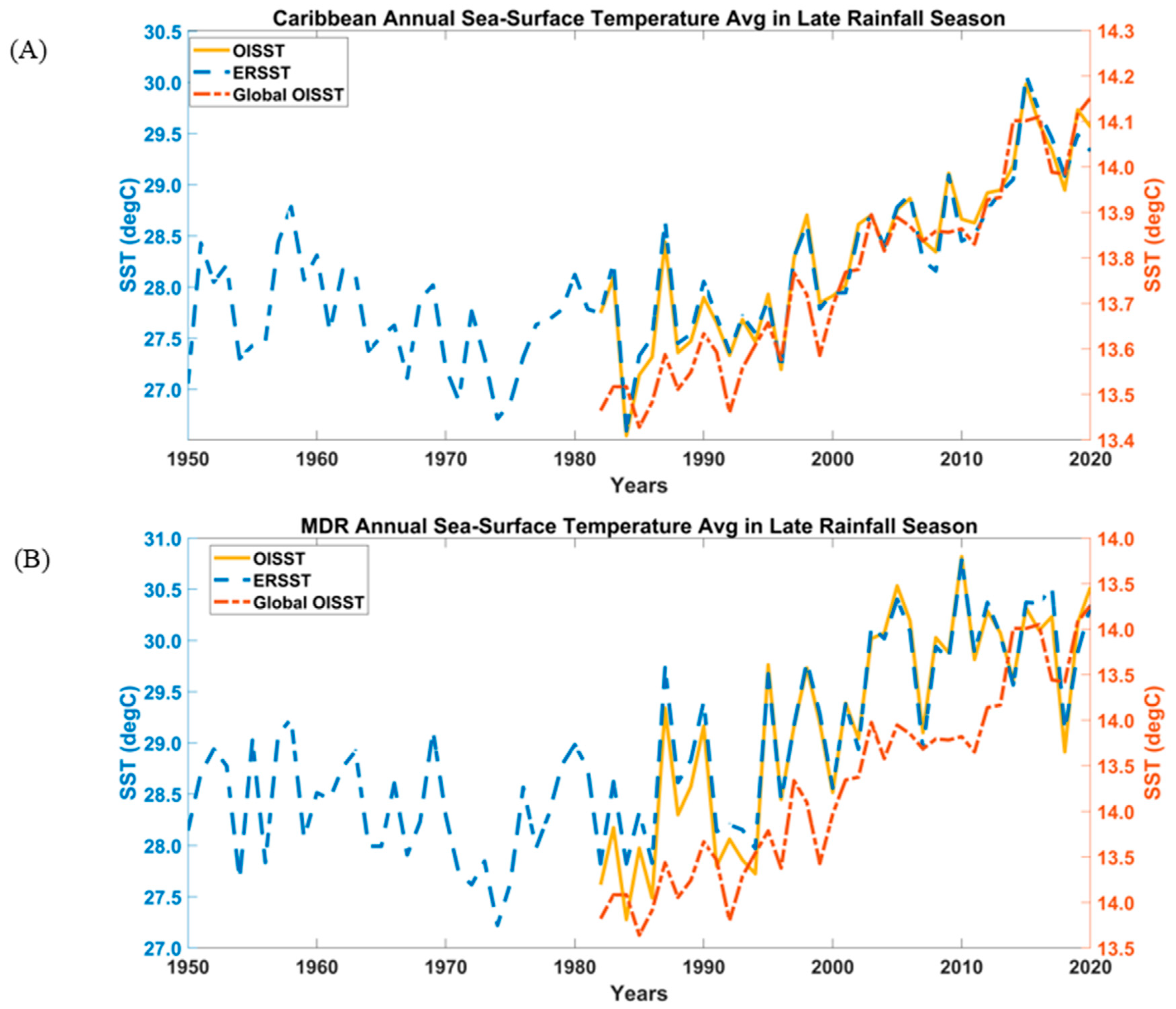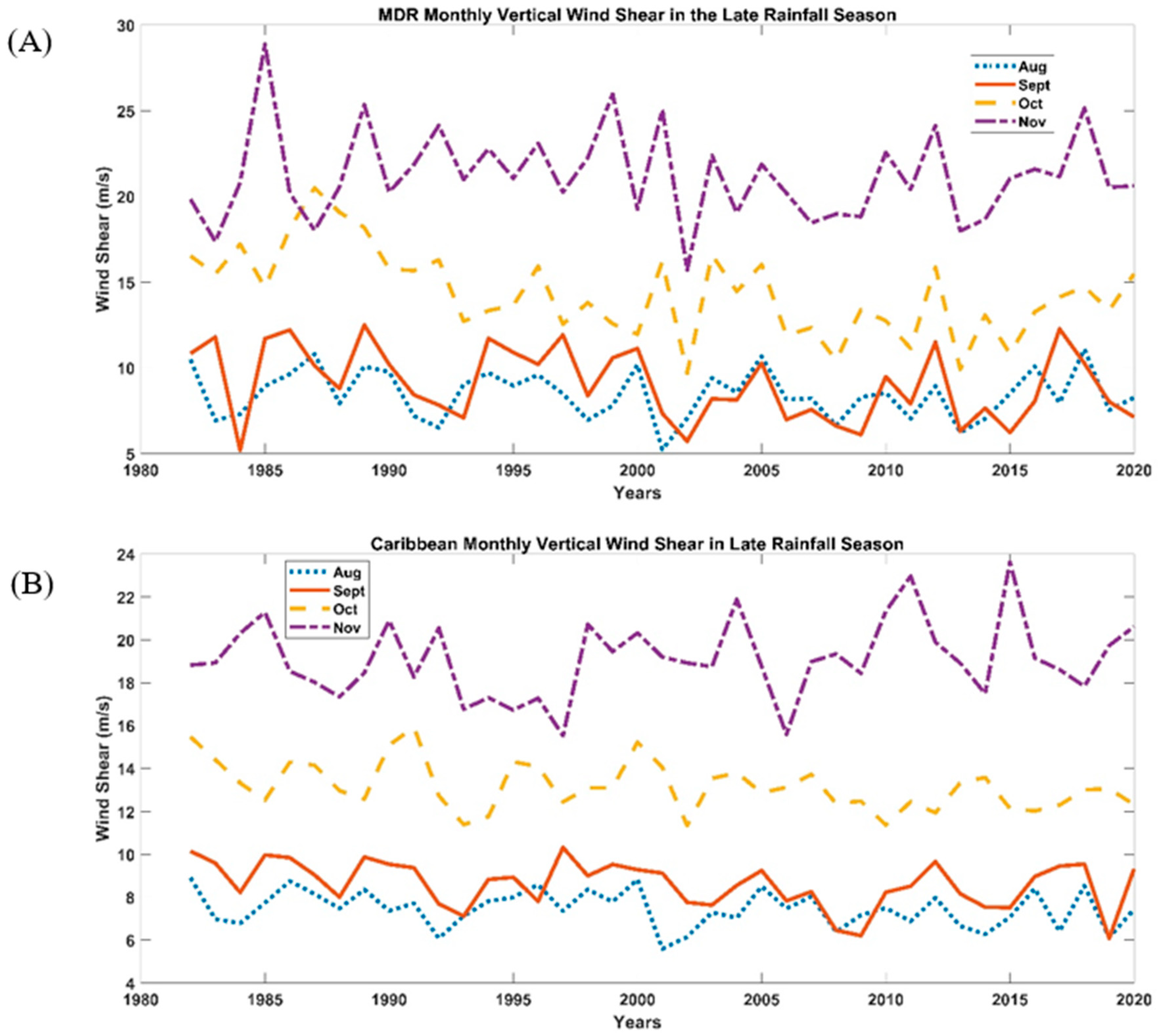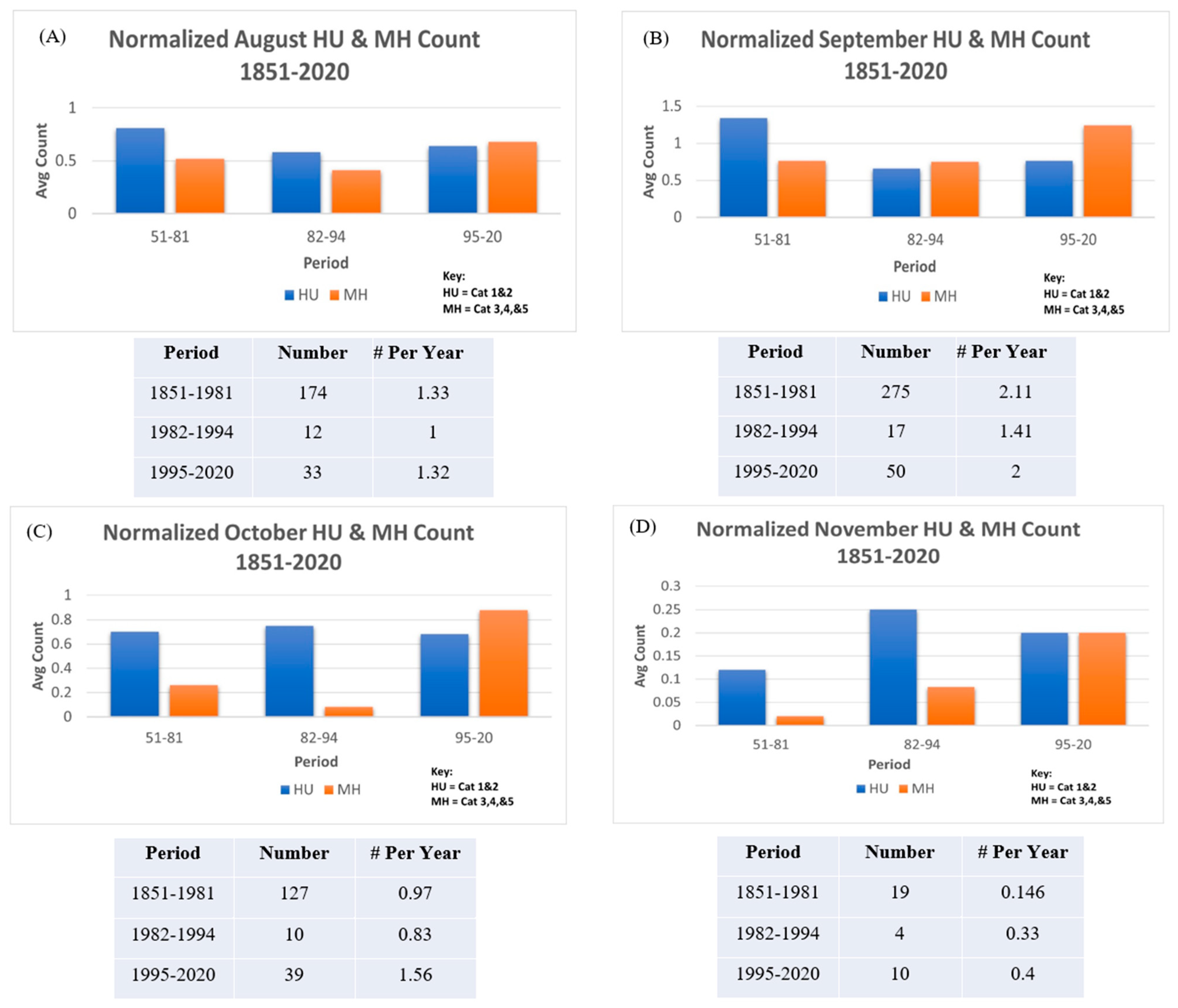Changes to Sea Surface Temperatures and Vertical Wind Shear and Their Influence on Tropical Cyclone Activity in the Caribbean and the Main Developing Region
Abstract
1. Introduction
2. Materials and Methods
2.1. Analytical Techniques
2.2. Regional Analysis
2.3. Trends and Grid Analysis
2.4. Correlations
2.5. Hurricane Count and Intensity
2.6. Atlantic Warm Pool
3. Results
3.1. Observations of Sea Surface Temperatures and the Atlantic Warm Pool Trends
3.2. SST and the Atlantic Multidecadal Oscillation (AMO)
3.3. Examination of Hurricane Frequency and Intensity
3.4. Correlations and Vertical Wind Shear
4. Discussion and Conclusions
Author Contributions
Funding
Institutional Review Board Statement
Informed Consent Statement
Data Availability Statement
Acknowledgments
Conflicts of Interest
References
- Antuña-Marrero, J.C.; Otterå, O.H.; Robock, A.; Mesquita, M.d.S. Modelled and Observed Sea Surface Temperature Trends for the Caribbean and Antilles: Sea Surface Temperature Trends for the Caribbean and Antilles. Int. J. Climatol. 2016, 36, 1873–1886. [Google Scholar] [CrossRef]
- Glenn, E.; Comarazamy, D.; González, J.E.; Smith, T. Detection of Recent Regional Sea Surface Temperature Warming in the Caribbean and Surrounding Region. Geophys. Res. Lett. 2015, 42, 6785–6792. [Google Scholar] [CrossRef]
- Glenn, E.; Smith, T.M.; Gálvez, J.M.; Davison, M.; Hibbert, K.; González, J.E. Tropical Convection in the Caribbean and Surrounding Region during a Regional, Warming Sea-Surface Temperature Period, 1982–2020. Hydrology 2021, 8, 56. [Google Scholar] [CrossRef]
- Gadgil, S.; Joseph, P.V.; Joshi, N.V. Ocean–Atmosphere Coupling over Monsoon Regions. Nature 1984, 312, 141–143. [Google Scholar] [CrossRef]
- Graham, N.E.; Barnett, T.P. Sea Surface Temperature, Surface Wind Divergence, and Convection over Tropical Oceans. Science 1987, 238, 657–659. [Google Scholar] [CrossRef]
- Melillo, J.M.; Richmond, T.T.C.; Yohe, G.W. Climate Change Impacts in the United States: The Third National Climate Assessment; U.S. Global Change Research Program: Washington, DC, USA, 2014. [Google Scholar] [CrossRef]
- Pachauri, R.K.; Mayer, L.; Intergovernmental Panel on Climate Change (Eds.) Climate Change 2014: Synthesis Report; Intergovernmental Panel on Climate Change: Geneva, Switzerland, 2015. [Google Scholar]
- Shapiro, L.J.; Goldenberg, S.B. Atlantic Sea Surface Temperatures and Tropical Cyclone Formation. J. Clim. 1998, 11, 578–590. [Google Scholar] [CrossRef]
- Chand, S.S.; Walsh, K.J.E.; Camargo, S.J.; Kossin, J.P.; Tory, K.J.; Wehner, M.F.; Chan, J.C.L.; Klotzbach, P.J.; Dowdy, A.J.; Bell, S.S.; et al. Declining Tropical Cyclone Frequency under Global Warming. Nat. Clim. Chang. 2022, 12, 655–661. [Google Scholar] [CrossRef]
- Taylor, M.A.; Stephenson, K.A. Impacts of Climate Change on Sea Temperature in the Coastal and Marine Environments of Caribbean Small Island Developing States. Caribb. Mar. Clim. Cange Rep. Card Sci. Rev. 2017, 201, 23–30. [Google Scholar]
- Mann, M.E.; Emanuel, K.A. Atlantic Hurricane Trends Linked to Climate Change. Eos Trans. AGU 2006, 87, 233. [Google Scholar] [CrossRef]
- Vecchi, G.A.; Soden, B.J. Increased Tropical Atlantic Wind Shear in Model Projections of Global Warming: Atlantic Wind Shear and Global Warming. Geophys. Res. Lett. 2007, 34. [Google Scholar] [CrossRef]
- Riahi, K.; Rao, S.; Krey, V.; Cho, C.; Chirkov, V.; Fischer, G.; Kindermann, G.; Nakicenovic, N.; Rafaj, P. RCP 8.5—A Scenario of Comparatively High Greenhouse Gas Emissions. Clim. Chang. 2011, 109, 33–57. [Google Scholar] [CrossRef]
- Nurse, L.A.; Charlery, J.L. Projected SST Trends across the Caribbean Sea Based on PRECIS Downscaling of ECHAM4, under the SRES A2 and B2 Scenarios. Theor. Appl. Climatol. 2016, 123, 199–215. [Google Scholar] [CrossRef]
- Emanuel, K.A. An Air–sea Interaction Theory for Tropical Cyclones. Part I: Steady-State Maintenance. J. Atmos. Sci. 1986, 43, 585–605. [Google Scholar] [CrossRef]
- Huang, B.; Liu, C.; Banzon, V.; Freeman, E.; Graham, G.; Hankins, B.; Smith, T.; Zhang, H.-M. Improvements of the Daily Optimum Interpolation Sea Surface Temperature (DOISST) Version 2.1. J. Clim. 2021, 34, 2923–2939. [Google Scholar] [CrossRef]
- Huang, B.; Menne, M.J.; Boyer, T.; Freeman, E.; Gleason, B.E.; Lawrimore, J.H.; Liu, C.; Rennie, J.J.; Schreck, C.J.; Sun, F.; et al. Uncertainty Estimates for Sea Surface Temperature and Land Surface Air Temperature in NOAAGlobalTemp Version 5. J. Clim. 2020, 33, 1351–1379. [Google Scholar] [CrossRef]
- Wang, C.; Lee, S.-K.; Enfield, D.B. Atlantic Warm Pool Acting as a Link between Atlantic Multidecadal Oscillation and Atlantic Tropical Cyclone Activity: Atlantic Tropical Cyclone Activity. Geochem. Geophys. Geosyst. 2008, 9. [Google Scholar] [CrossRef]
- Wang, C.; Lee, S. Atlantic Warm Pool, Caribbean Low-Level Jet, and Their Potential Impact on Atlantic Hurricanes. Geophys. Res. Lett. 2007, 34, L02703. [Google Scholar] [CrossRef]
- Fiedler, S.; Putrasahan, D. How Does the North Atlantic SST Pattern Respond to Anthropogenic Aerosols in the 1970s and 2000s? Geophys. Res. Lett. 2021, 48, e2020GL092142. [Google Scholar] [CrossRef]
- Shapiro, L.J. Hurricane Climatic Fluctuations. Part I: Patterns and Cycles. Mon. Wea. Rev. 1982, 110, 1007–1013. [Google Scholar] [CrossRef]
- Enfield, D.B.; Mestas-Nuñez, A.M.; Trimble, P.J. The Atlantic Multidecadal Oscillation and Its Relation to Rainfall and River Flows in the Continental U.S. Geophys. Res. Lett. 2001, 28, 2077–2080. [Google Scholar] [CrossRef]
- Vecchi, G.A.; Landsea, C.; Zhang, W.; Villarini, G.; Knutson, T. Changes in Atlantic Major Hurricane Frequency since the Late-19th Century. Nat. Commun. 2021, 12, 4054. [Google Scholar] [CrossRef] [PubMed]
- Emanuel, K. The Hurricane—Climate Connection. Bull. Amer. Meteor. Soc. 2008, 89, ES10–ES20. [Google Scholar] [CrossRef]
- Knutson, T.; Camargo, S.J.; Chan, J.C.L.; Emanuel, K.; Ho, C.-H.; Kossin, J.; Mohapatra, M.; Satoh, M.; Sugi, M.; Walsh, K.; et al. Tropical Cyclones and Climate Change Assessment: Part II: Projected Response to Anthropogenic Warming. Bull. Am. Meteorol. Soc. 2020, 101, E303–E322. [Google Scholar] [CrossRef]
- Kossin, J.P.; Knapp, K.R.; Olander, T.L.; Velden, C.S. Global Increase in Major Tropical Cyclone Exceedance Probability over the Past Four Decades. Proc. Natl. Acad. Sci. USA 2020, 117, 11975–11980. [Google Scholar] [CrossRef] [PubMed]
- Bjerknes, J. Atlantic Air–sea Interaction. In Advances in Geophysics; Elsevier: Amsterdam, The Netherlands, 1964; Volume 10, pp. 1–82. [Google Scholar] [CrossRef]
- Shukla, J.; Misra, B.M. Relationships between Sea Surface Temperature and Wind Speed over the Central Arabian Sea, and Monsoon Rainfall over India. Mon. Wea. Rev. 1977, 105, 998–1002. [Google Scholar] [CrossRef]
- Hurrell, J.W. Decadal Trends in the North Atlantic Oscillation: Regional Temperatures and Precipitation. Science 1995, 269, 676–679. [Google Scholar] [CrossRef]
- Wang, C.; Weisberg, R.H.; Yang, H. Effects of the Wind Speed–Evaporation–SST Feedback on the El Niño–Southern Oscillation. J. Atmos. Sci. 1999, 56, 1391–1403. [Google Scholar] [CrossRef]
- Xie, S.-P. Satellite Observations of Cool Ocean–Atmosphere Interaction. Bull. Am. Meteorol. Soc. 2004, 85, 195–208. [Google Scholar] [CrossRef]
- QU, B.; Jing-nan, Z.; Dao-rong, L.; Feng, Q.; Min, Z. Correlation between Sea Surface Temperature and Wind Speed in Greenland Sea and Their Relationships with NAO Variability. Sci. Direct 2012, 5, 304–315. [Google Scholar] [CrossRef]
- Xian, T.; Xia, J.; Wei, W.; Zhang, Z.; Wang, R.; Wang, L.-P.; Ma, Y.-F. Is Hadley Cell Expanding? Atmosphere 2021, 12, 1699. [Google Scholar] [CrossRef]
- Gray, W.M. Global View of the Origin of Tropical Disturbances and Storms. Mon. Wea. Rev. 1968, 96, 669–700. [Google Scholar] [CrossRef]
- DeMaria, M. The Effect of Vertical Shear on Tropical Cyclone Intensity Change. J. Atmos. Sci. 1996, 53, 2076–2088. [Google Scholar] [CrossRef]
- Wang, Y.; Rao, Y.; Tan, Z.-M.; Schönemann, D. A Statistical Analysis of the Effects of Vertical Wind Shear on Tropical Cyclone Intensity Change over the Western North Pacific. Mon. Weather. Rev. 2015, 143, 3434–3453. [Google Scholar] [CrossRef]
- Emanuel, K.A. The Finite-Amplitude Nature of Tropical Cyclogenesis. J. Atmos. Sci. 1989, 46, 3431–3456. [Google Scholar] [CrossRef]
- Powell, M.D. Boundary Layer Structure and Dynamics in Outer Hurricane Rainbands. Part II: Downdraft Modification and Mixed Layer Recovery. Mon. Wea. Rev. 1990, 118, 918–938. [Google Scholar] [CrossRef]
- Frank, W.M.; Ritchie, E.A. Effects of Vertical Wind Shear on the Intensity and Structure of Numerically Simulated Hurricanes. Mon. Wea. Rev. 2001, 129, 2249–2269. [Google Scholar] [CrossRef]
- Chan, K.T.F.; Wang, D.; Zhang, Y.; Wanawong, W.; He, M.; Yu, X. Does Strong Vertical Wind Shear Certainly Lead to the Weakening of a Tropical Cyclone? Environ. Res. Commun. 2019, 1, 015002. [Google Scholar] [CrossRef]
- Emanuel, K. Evidence That Hurricanes Are Getting Stronger. Proc. Natl. Acad. Sci. USA 2020, 117, 13194–13195. [Google Scholar] [CrossRef]
- Emanuel, K.A. The Dependence of Hurricane Intensity on Climate. Nature 1987, 326, 483–485. [Google Scholar] [CrossRef]
- Wang, C. ENSO, Atlantic Climate Variability, and the Walker and Hadley Circulations. In The Hadley Circulation: Present, Past and Future; Diaz, H.F., Bradley, R.S., Beniston, M., Eds.; Advances in Global Change Research; Springer: Dordrecht, The Netherlands, 2004; Volume 21, pp. 173–202. [Google Scholar] [CrossRef]
- Yang, Y.; Zhu, Z.; Shen, X.; Jiang, L.; Li, T. The Influences of Atlantic Sea Surface Temperature Anomalies on the ENSO-Independent Interannual Variability of East Asian Summer Monsoon Rainfall. J. Clim. 2022, 36, 677–692. [Google Scholar] [CrossRef]
- Lin, I.; Camargo, S.J.; Patricola, C.M.; Boucharel, J.; Chand, S.; Klotzbach, P.; Chan, J.C.L.; Wang, B.; Chang, P.; Li, T.; et al. ENSO and Tropical Cyclones. In Geophysical Monograph Series; McPhaden, M.J., Santoso, A., Cai, W., Eds.; Wiley: New York, NY, USA, 2020; pp. 377–408. [Google Scholar] [CrossRef]
- Wang, Z.; Boyer, T.; Reagan, J.; Hogan, P. Upper Oceanic Warming in the Gulf of Mexico between 1950 and 2020. J. Clim. 2023, 36. [Google Scholar] [CrossRef]










| SST and VWS Correlations with the Caribbean and Surrounding Region Storm Intensities. | |||||
|---|---|---|---|---|---|
| Cat 1 | Cat 2 | Cat 3 | Cat 4 | Cat 5 | |
| SST LRS | <10−3 | 0.002 | 0.198 | 0.007 | 0.037 |
| VWS LRS | 0.013 | 0.007 | 0.008 | 0.038 | 0.001 |
| SST and VWS Correlations with Storm Intensities in the MDR. | |||||
| Cat 1 | Cat 2 | Cat 3 | Cat 4 | Cat 5 | |
| SST LRS | 0.002 | 0.003 | 0.273 | 0.038 | 0.033 |
| VWS LRS | <10−3 | 0.008 | 0.058 | 0.001 | 0.040 |
Disclaimer/Publisher’s Note: The statements, opinions and data contained in all publications are solely those of the individual author(s) and contributor(s) and not of MDPI and/or the editor(s). MDPI and/or the editor(s) disclaim responsibility for any injury to people or property resulting from any ideas, methods, instructions or products referred to in the content. |
© 2023 by the authors. Licensee MDPI, Basel, Switzerland. This article is an open access article distributed under the terms and conditions of the Creative Commons Attribution (CC BY) license (https://creativecommons.org/licenses/by/4.0/).
Share and Cite
Hibbert, K.; Glenn, E.; Smith, T.M.; González-Cruz, J.E. Changes to Sea Surface Temperatures and Vertical Wind Shear and Their Influence on Tropical Cyclone Activity in the Caribbean and the Main Developing Region. Atmosphere 2023, 14, 999. https://doi.org/10.3390/atmos14060999
Hibbert K, Glenn E, Smith TM, González-Cruz JE. Changes to Sea Surface Temperatures and Vertical Wind Shear and Their Influence on Tropical Cyclone Activity in the Caribbean and the Main Developing Region. Atmosphere. 2023; 14(6):999. https://doi.org/10.3390/atmos14060999
Chicago/Turabian StyleHibbert, Keneshia, Equisha Glenn, Thomas M. Smith, and Jorge E. González-Cruz. 2023. "Changes to Sea Surface Temperatures and Vertical Wind Shear and Their Influence on Tropical Cyclone Activity in the Caribbean and the Main Developing Region" Atmosphere 14, no. 6: 999. https://doi.org/10.3390/atmos14060999
APA StyleHibbert, K., Glenn, E., Smith, T. M., & González-Cruz, J. E. (2023). Changes to Sea Surface Temperatures and Vertical Wind Shear and Their Influence on Tropical Cyclone Activity in the Caribbean and the Main Developing Region. Atmosphere, 14(6), 999. https://doi.org/10.3390/atmos14060999








